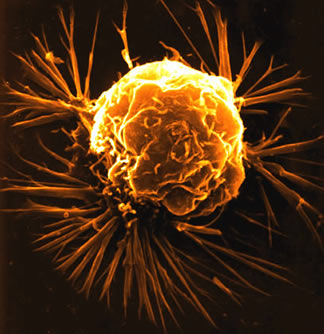Cancer Did You Knows!

New cases: 1,437,180 (does not include nonmelanoma skin cancers)
Deaths: 565,650
KEY POINTS
1)The survival rate for many types of cancer has improved in recent years; however, cancer is still the second leading cause of death in the United States
2)Cancer occurs when cells continue to grow and divide and do not die when they should. Cancer cells can damage or destroy nearby tissues and can metastasize (spread) to distant parts of the body through the bloodstream or lymphatic system
3)Cancer is the result of changes in the genes that control normal cell growth and death. These changes may be inherited, or may result from environmental or lifestyle factors
4)People can reduce their risk of cancer by adopting a healthy lifestyle. Also, screening exams can detect some precancerous conditions and early-stage cancer
5)Cancer can cause a variety of symptoms
6)Cancer can be treated with surgery, radiation therapy, chemotherapy, hormones, and/or biological therapy
Cancer is the second leading cause of death in this country. However, improvements in cancer detection, diagnosis, and treatment have increased the survival rate for many types of cancer. About 64 percent of all people diagnosed with cancer will be alive 5 years after diagnosis (1).
What is cancer?
Cancer is a group of many related diseases that begin in cells, the body’s basic building blocks. To understand cancer, it is helpful to know what happens when normal cells become cancerous.
The body is made up of many types of cells. Normally, cells grow and divide to produce more cells as they are needed to keep the body healthy. Sometimes, this orderly process goes wrong. New cells form when the body does not need them, and old cells do not die when they should. The extra cells form a mass of tissue called a growth or tumor. Not all tumors are cancerous; tumors can be benign or malignant.
Although there is no guaranteed way to prevent cancer, people can reduce their risk (chance) of developing cancer by:
not using tobacco products
choosing foods with less fat and eating more vegetables, fruits, and whole grains
exercising regularly and maintaining a lean weight
avoiding the harmful rays of the sun, using sunscreen, and wearing clothing that protects the skin
talking with a doctor about the possible benefits of drugs proven to reduce the risk of certain cancers
Although many risk factors can be avoided, some, such as inherited conditions, are unavoidable. Still, it is helpful to be aware of them. It is also important to keep in mind that not everyone with a particular risk factor for cancer actually gets the disease; in fact, most do not. People who have an increased likelihood of developing cancer can help protect themselves by avoiding risk factors (see Question 2) whenever possible and by getting regular checkups so that, if cancer develops, it is likely to be found and treated early. Treatment is often more effective when cancer is detected early. Screening exams, such as sigmoidoscopy or the fecal occult blood test, mammography, and the Pap test, can detect precancerous conditions (which can be treated before they turn into cancer) and early-stage cancer.
Cancer can cause a variety of symptoms.
new thickening or lump in the breast or any other part of the body
new mole or an obvious change in the appearance of an existing wart or mole
a sore that does not heal
nagging cough or hoarseness
changes in bowel or bladder habits
persistent indigestion or difficulty swallowing
unexplained changes in weight
unusual bleeding or discharge
When these or other symptoms occur, they are not always caused by cancer. They can be caused by infections, benign tumors, or other problems. It is important to see a doctor about any of these symptoms or about other physical changes. Only a doctor can make a diagnosis. A person with these or other symptoms should not wait to feel pain because early cancer usually does not cause pain.
If symptoms occur, the doctor may perform a physical examination, order blood work and other tests, and/or recommend a biopsy. In most cases, a biopsy is the only way to know for certain whether cancer is present. During a biopsy, the doctor removes a sample of tissue from the abnormal area. A pathologist studies the tissue under a microscope to identify cancer cells
Cancer treatment can include surgery, radiation therapy, chemotherapy, hormone therapy, and biological therapy. The doctor may use one method or a combination of methods, depending on the type and location of the cancer, whether the disease has spread, the patient’s age and general health, and other factors. Because treatment for cancer can also damage healthy cells and tissues, it often causes side effects. Some patients may worry that the side effects of treatment are worse than the disease. However, patients and doctors generally discuss the treatment options, weighing the likely benefits of killing cancer cells and the risks of possible side effects. Doctors can suggest ways to reduce or eliminate problems that may occur during and after treatment.
Having cancer does not always mean having pain. Whether a patient has pain may depend on the type of cancer, the extent of the disease, and the patient’s tolerance for pain. Most pain occurs when the cancer grows and presses against bones, organs, or nerves. Pain may also be a side effect of treatment. However, pain can generally be relieved or reduced with prescription medicines or over-the-counter drugs recommended by the doctor. Other ways to reduce pain, such as relaxation exercises, may also be useful. Pain should not be accepted as an unavoidable part of having cancer. It is important for patients to talk about pain so steps can be taken to help relieve it. In addition, changing the dose or type of medication can usually help if the patient has troublesome side effects.


0 Comments:
Post a Comment
<< Home